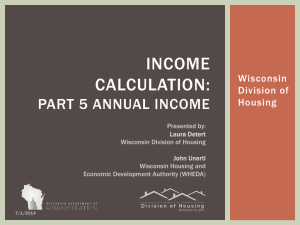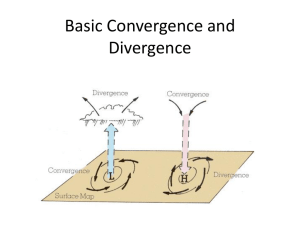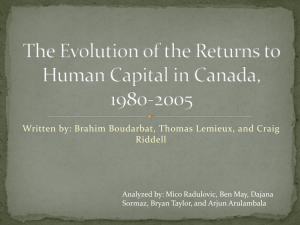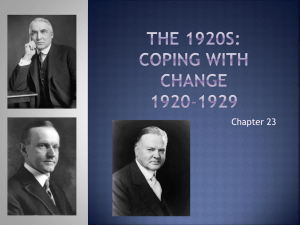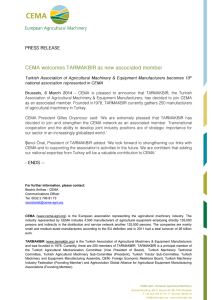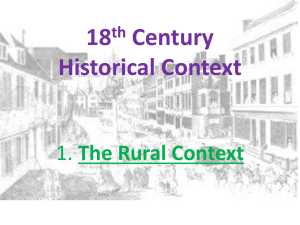The Great Divergence in World Incomes: Why Are
advertisement
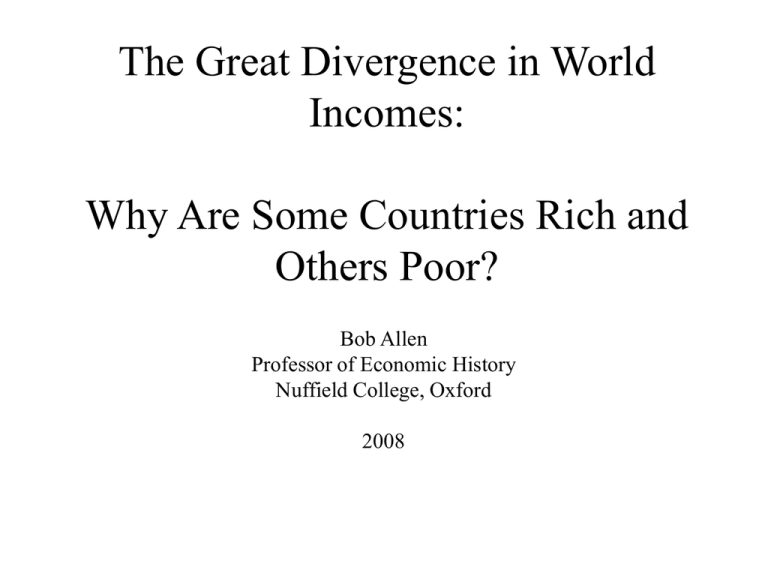
The Great Divergence in World Incomes: Why Are Some Countries Rich and Others Poor? Bob Allen Professor of Economic History Nuffield College, Oxford 2008 Part 1: When did Northwestern Europe pull ahead of the Rest of the World? The Great Divergence Debate • The classical economists and most scholars since have argued that Europe was ahead of Asia for a very long time. They try to explain why: – Smith: Minimal government and openness to trade – Malthus: Differences in marriage patterns – Marx: capitalist versus other institutions (Asiatic mode of production) The California School has challenged this. • Key books: – Ken Pomeranz, The Great Divergence – Bin Wong, China Transformed – James Lee and Wang Feng, One Quarter of Humanity: Malthusian Mythology and Chinese Realities • They claim that income differences between Europe and Asia were small c. 1800 and Asian institutions were adequate for development. • Evidence for incomes is very weak. I will argue that the California School is wrong and that northwestern Europe pulled ahead of Asia 1500-1750. • I begin by measuring income differences. • Maddison’s GDP estimates are very unrealiable. • Instead I rely on real wages. They measure the incomes of workers and perhaps other people as well. Measuring real wages requires data on wages and consumer prices. • These are available for many European cities in price histories. – Many have been written in last 150 years – Historian finds an institution that has lasted hundreds of years and copies prices of all transactions. – Published in books • I have computerized these – Weights and measures converted to metric – Money converted to grams of silver • This work is being extended to Asia The first efforts were for Europe, followed quickly by the Ottoman Empire: • Jan Luiten van Zanden, “Wages, and the Standards of Living in Europe,” European Review of Economic History, 1999, 175-98. • Robert C. Allen, ‘The Great Divergence in European Wages and Prices,’ Explorations in Economic History, 2001, 411-447. • S. Őzmucur and S. Pamuk, ‘Real Wages and Standards of Living in the Ottoman Empire,” Journal of Economic History, 2002, 293-321. Now this research is being extended to Asia: • D Ma and J-P Bassino, “Japanese Unskilled Wages in International Perspective,” Research in Economic History, 2005. • RC Allen, J-P Bassino, D Ma, C Moll-Murata, J-L van Zanden, ‘Wages, prices, and Living Standards in China, Japan, and Europe, 1738-1925” • RC Allen, “India in the Great Divergence,” in Hatton, O’Rourke, Taylor, eds., The New Comparative Economic History: Essays in Honor of Jeffery G. Williamson, 2007, pp. 9-32. These studies involve comparing: • Wage rates, which are usually expressed in grams of silver per day. • Consumer prices: usually the cost of a ‘basket of goods’. • Welfare ratio: a full year’s earnings divided by the cost of maintaining a family for a year. Here’s how daily wages compared: g r a m s o f s ilv e r p e r d a y Labourers' wages around the world 20 London 15 Amsterdam Vienna 10 Florence 5 Delhi 0 1375 1475 1575 1675 1775 Beijing Did high silver wages translate into a high standard of living? The answer depends on the cost of living! To measure the cost of living: • Collect prices of all of the important consumer goods. • These must be converted to grams of silver per metric unit. • A basket of goods must be specified and its cost computed. A basket is specified for an adult male covering a whole year. • Various standards of comfort could be chosen. • My first basket was what I now call the European respectability basket. This is supposed to represent total, annual spending for a man. • This supplies 1940 kcalories per day. • It was inspired by eighteenth century budgets and poor house diets. • Bread is the main carbohydrate. Beer or wine and meat are included. • Non-foods are included. • Rent at 5% is added on. Welfare ratio for a family: • WR=Annual income/annual cost of subsistence • Annual income = man’s annual income assuming full time, full year work • Annual cost of subsistence = 3 times cost of basket (including 5% for rent). • This annual subsistence cost includes man, woman, and children • If WR=1, income is just enough to buy the specified basket or standard of living. Roman Empire c. 300 AD The problem with this basket is that it is too expensive for most people in the world! • Therefore, I constructed a ‘bare bones’ minimum basket. This is supposed to represent total, annual spending for a man. • This also supplies 1940 kcalories per day, mainly from the cheapest grain. • Small amounts of meat, beans, butter, or oil to supply protein and fat in keeping with local diet. • Small quantities of non-foods are included. • Rent at 5% is added on. Subsistence Incomes: Baskets of Goods European oats Beijing sorghum quantity nutrients/day quantiy nutrients/day per person grams of per person grams of per year calories protein per year calories prot sorghum oats 163 rice millet bread beans/peas 5 meat 5 butter/oil 3 cheese 3 eggs beer sugar soap 1.3 linen/cotton 3 candles 1.3 lamp oil 1.3 fuel 3.0 total kg 1745 75 kg kg kg kg 47 34 60 31 4 3 0 2 kg m kg l M BTU 1914 156 1453 48 39.52 8 3 370 34 60 28 3 0 1917 79 3 m 2.0 M BTU 84 The Great Divergence in Living Standards Happened 1400-1750 Subsistence Ratio for Labourers income/cost of subsistence basket 6 London 5 Amsterdam 4 Vienna 3 2 Florence 1 Delhi 0 1375 1475 1575 1675 1775 1875 Beijing Workers around the World earned incomes 3 – 4 times subsistence in 1400. • Some of the surplus was spent on more calories. • Much of the surplus was spent on better quality food—meat, alcohol. The Great Divergence preceded the Industrial Revolution: • English and Dutch workers still earned 3 – 4 times subsistence. • They provided the mass market for the ‘consumer revolution.’ • Workers in India, China, and south and central Europe earned only enough to survive (Welfare Ratio = 1). Part II: Why did northwest Europe pull ahead? The immediate explanation is that the high wage economies were economically more developed: 1500 1800 rural nonagriurban culture agric rural nonagri urban culture agric greatest transformation England .07 .18 .74 .29 .36 .35 significant modernization Netherlands .30 Belgium .28 .14 .14 .56 .58 .34 .22 .25 .29 .41 .49 slight evolution Germany France Austria/Hungary Poland .08 .09 .05 .06 .18 .18 .19 .19 .73 .73 .76 .75 .09 .13 .08 .05 .29 .28 .35 .39 .62 .59 .57 .56 little change Italy Spain .22 .19 .16 .16 .62 .65 .22 .20 .20 .16 .58 .64 Wage was maintained in northwest Europe (W) and fell elsewhere (W1) Why was northwest Europe more successful? • Legal, constitutional, institutional development? • Culture? • In keeping with the assessment of Marxism, I investigate: – Agrarian structure? No – Commercial expansion? Yes • I will review evidence about agriculture and about energy to argue that urban growth was a cause of these developments. Agricultural revolution Commercial expansion Urban growth Cheap energy (coal) High wages Agriculture did play an important role: output per worker Output per worker is agricultural output divided by the agricultural population from earlier population breakdown. • Agricultural output is calculated from a demand curve. • Other investigators have used this procedure for Spain, the Netherlands, and Italy. • This procedure makes per capita consumption of agricultural products a function of income and price. – Q = P-.6W.5M.1N – P = price, W = wage income, M=price manufactures, N=population – Estimates of net agricultural exports must be added to go from consumption to production. • The output estimates are consistent with direct calculations for England and the Netherlands. Standard explanation emphasizes enclosures and capitalist farming: Surviving medieval ridge and furrow In fact, these institutional changes made only minor contributions to productivity growth: Much of the incentive to increase productivity was a response to the growth of cities: Sir James Steuart (1767) had the essential insight: “a farmer will not labour to produce a superfluity of grain relative to his own consumption, unless he finds some want which may be supplied by the means of the superfluity.” Sixty years later, Gibbon Wakefield spelled out the global context: “In England, the greatest improvements have taken place continually, ever since colonization has continually produced new desires amongst the English, and new markets wherein to purchase the objects of desire. With the growth of sugar and tobacco in America, came the more skillful growth of corn in England. Because in England, sugar was drank and tobacco smoked, corn was raised with less labour, by fewer hands. If farmer’s increased output, they could keep up with high wage economy: The Growth of London created cheap energy: • London population – 1500: 50,000 – 1600: 200,000 – 1700: 500,000 – 1800: 1,000,000 • This growth created the British coal industry, which was unique in the world. • The British coal industry gave Britain the cheapest energy in the world. • Cheap energy led to invention of energy using technology and the expansion of energy using industries. As a result, northern and western Britain had the cheapest energy in the world. Next challenge: Put these ideas together in a model that separates out the causes of success and failure in the early modern economy: • Things to explain (endogenous variables) – Real wage – Urbanization – Agricultural productivity – Proto-industrialization • Explanatory factors (exogenous variables) – population – Agricultural land – Productivity in textiles (new draperies) – Intercontinental trade (result of imperial policy) – Price of energy – Prince or republic – literacy A data base is put together • Countries at fifty or one hundred year intervals • Uses earlier occupational distribution data • Agricultural total factor productivity estimated from output, land, and labour • Other variables like textile productivity, literacy, trade data are calculated. Textile productivity is measured as the ratio of input prices (wool, labour) to cloth price: Energy price Equations of Motion of the Early Modern Economy Wage equation LNWAGE = .23 LNURB +.54 LNAGTFP +.40LNTL -.03PRINCE -.66 Agricultural productivity equation LNAGTFP = .23 LNURB + .50 LNPROTO +.44 LNWAGE +.18 ENCL +.06 PRINCE +.40 Urbanization equation LNURB = .40 LNAGTFP +.10 TRADEPOP -.14 LNPENERGY + .79 LNURBLAG + .05 PRINCE - .28 Proto-Industry equation LNPROTO = -.93 LNAGTFP -1.00 LNWAGE +1.27 MANPROD -.18 PRINCE -.80 The model is tested by seeing if it replicates the various national histories. Here is the simulated wage: 10 9 England 8 Italy 7 France 6 Nether 5 1300 1500 1700 1800 Simulated agricultural TFP 2 1.8 England 1.6 Italy 1.4 France 1.2 Nether 1 0.8 1300 1500 1700 1800 Simulated urbanization rates: 0.35 0.3 England 0.25 Italy 0.2 France 0.15 Nether 0.1 0.05 1300 1500 1700 1800 We can use the model to identify the causes of England’s advance. Can we turn England into France? Here are simulated wages: 10 sim act 9 no rep 8 no encl 7 no man 6 no trade 5 no coal 1300 1500 1700 1800 Simulated urbanization 0.35 sim act 0.3 no rep 0.25 no encl 0.2 no man 0.15 no trade 0.1 0.05 no coal 1300 1500 1700 1800 Simulated agricultural TFP 1.8 sim act 1.6 no rep 1.4 no encl 1.2 no man no trade 1 0.8 no coal 1300 1500 1700 1800 The Great Divergence was mainly the result of English and Dutch success in the world economy. • To a significant extent, this was successful mercantilism. • England and the low countries were the high wage part of the world. • England was also the cheap energy region of the world. Part III: Why did the early modern Great Divergence lead to the Industrial Revolution? The problem is explaining why the steam engine, cotton spinning, coke smelting, etc., were invented and adopted in Britain in the 18th century. • These were macro-inventions – Radically changed factor proportions (biased technical change) – Great potential for elaboration – Ideas came from outside industry – Despite their revolutionary potential, they were barely viable commercially even under the most favourable circumstances. Were these technologies invented because of better ‘fundamentals’? • • • • Better property rights or limited government? No Better culture? No Better science? No Better geography? – Not better agricultural resources – Britain had developed coal but other countries had it. The macro-inventions were made in 18th century Britain because that was the first time and place that it paid to invent them. • The macro-inventions were biased technical changes. • They used inputs that were cheap in Britain and saved inputs that were dear. • Even under British conditions, they were barely profitable to operate. • They were not profitable to use elsewhere. Invention was an economic activity influenced by factor prices. • “Invention is 1% inspiration and 99% perspiration.” (Edison) – Inspiration for macro-inventions came from outside the industry (science, copying, and so forth) – Sometimes banal • Perspiration refers to R&D. – Perfecting the engineering was most of invention. – This entailed costs. • Factor prices determined adoption • Adoption determined benefits • Benefits necessary for R&D • Therefore, factor prices affected invention. Micro-inventions • • • • • Realized the potential of the macro-inventions Came from local learning Tended to produce neutral technical change Unleashed path dependent trajectory of improvement. Eventually cut costs enough to make the adoption of the macro-inventions profitable outside of Britain • When the ‘tipping point’ occurred, the Industrial Revolution spread abroad. Wage Relat ive to P rice of Capit al 8 7 6 5 4 3 2 1 1550 1600 N. England 1650 1700 Strasbourg 1750 Vienna 1800 Price of Labour re lative to Ene rgy early 1700s 5 Amsterdam 4 London 3 Paris 2 Strasbourg 1 Newcastle 0 Beijing The British inventions led to modern economic growth because they were more transformative. • Cotton was a global industry – Demand for British cotton was very price elastic – Technical improvements led to enormous output growth – This led to Manchester—vast urbanization – Also a very large demand for machinery • Steam engine and iron industries allowed – General mechanization of industry, railway, steam ship – Basis of 19th century global economy – Account for almost half of growth in British labour productivity in 19th century. • Engineering industry was the most important creation of British industrial revolution. The Great Divergence led to Modern Economic Growth—not the other way around.


